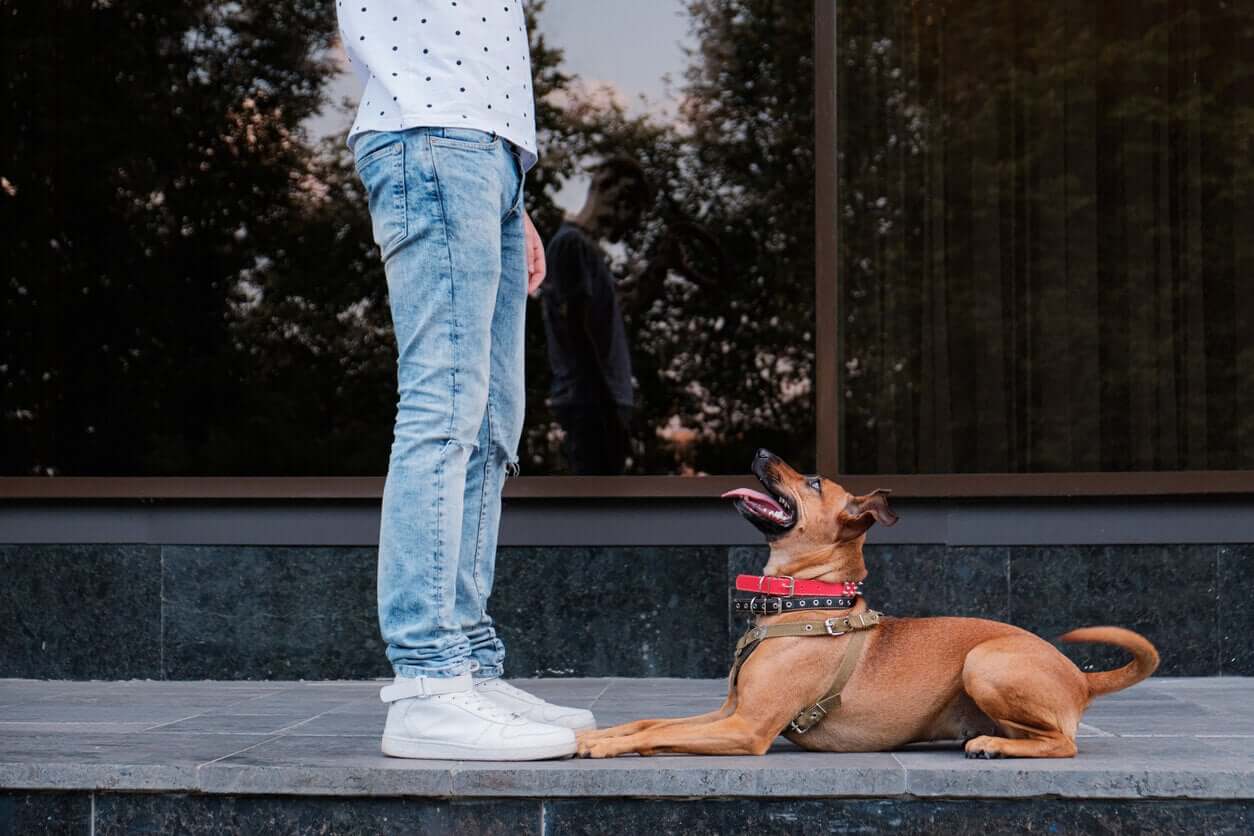Dog Therapies for Teens: What You Need to Know


Written and verified by the psychologist Mara Amor López
Dog therapies for teens have been shown to work. Substantial improvements have been observed in the emotional and communication aspects as well as the coexistence of at-risk children or with other types of challenges. Due to its positive results, it’s important to deepen the exploration and investment of this valuable resource that helps so many young people.
Animal-assisted therapies (AAT) aren’t only carried out with dogs, but also with other species as well, such as horses. They serve as a treatment strategy for many diseases, such as cardiac, mental, or oncological illnesses. In addition to this, they’ve also been seen to help at-risk teens improve in numerous ways.
If you want to know more about this tool and its benefits, be sure to read the following articles.
Dog therapies for teens

As we’ve anticipated, the help of dog therapies for teens is immense. For this reason, the Affinity Foundation has developed the Buddies program in collaboration with the Directorate-General for Attention to Children and Adolescents (DGAIA) in Catalunya, Spain.
This program is designed to help minors that are in care, as many of them come from difficult family and school environments, difficult social contexts, and many experiences of failure.
The main objective of this program is to teach young people to educate dogs through positive training. This requires them to learn to relate to dogs in a sensitive, assertive, and respectful way, which is the basis of any communication in life. They teach animals to respond to commands, while taking care of them, understanding them, and being attentive to their needs.
To fulfill the mission, adolescents must follow a methodology and be supervised by professionals who are experts in this type of therapy.
Dog therapies for teens with anorexia
The Niño Jesús University Children’s Hospital in Madrid has carried out a study on the effects of animal therapy in adolescents with bulimia and anorexia. This study has had the collaboration of the Rey Juan Carlos University and PURINA®.
During the therapy sessions, the young people between 13 and 17 years old participated in different dynamics with the dogs in order to work on their self-esteem, anxiety issues, and autonomy. At the end of the trial, improvements were observed on an emotional level and a marked increase in the self-esteem of these minors.
The results showed that pleasant emotions increased 46 points after the sessions. Likewise, the levels of depression, anxiety, and unpleasant emotions fell by 43 points at this same time.
What aspects can be worked on in dog therapies for teens?
As we’ve seen previously, the benefits of dog therapy are numerous. Through it, it’s possible to work on the management of emotions and the prevention of substance abuse, as animals are used as a way to attract the attention of children and encourage them to participate. In this way, it’s possible to reach the issues that affect them in their daily life in a more effective way than through conventional sessions.
Dog therapy for adolescents is a growing discipline, but one that needs a greater investment than it currently has. Some examples, like the ones we’ve looked at in this article, show that these treatment options are worth investing in.
Therapy can be focused on the resolution of some emotional problems or to get the adolescent’s attention in regard to the disclosure of information. It’s much easier to get the kids to listen to us and open up while spending time with the animals than through obligatory talks in high schools.

About the dog therapies for teens, we can say…
As you can see in this article, therapies with dogs for adolescents have given very good results. More and more professionals are using them as a way to help their patients, as animals are capable of increasing self-esteem and improving the management of emotions in young people with difficulties. Therefore, it’s important that they be given the recognition that this area of intervention requires.
Dog therapies for teens have been shown to work. Substantial improvements have been observed in the emotional and communication aspects as well as the coexistence of at-risk children or with other types of challenges. Due to its positive results, it’s important to deepen the exploration and investment of this valuable resource that helps so many young people.
Animal-assisted therapies (AAT) aren’t only carried out with dogs, but also with other species as well, such as horses. They serve as a treatment strategy for many diseases, such as cardiac, mental, or oncological illnesses. In addition to this, they’ve also been seen to help at-risk teens improve in numerous ways.
If you want to know more about this tool and its benefits, be sure to read the following articles.
Dog therapies for teens

As we’ve anticipated, the help of dog therapies for teens is immense. For this reason, the Affinity Foundation has developed the Buddies program in collaboration with the Directorate-General for Attention to Children and Adolescents (DGAIA) in Catalunya, Spain.
This program is designed to help minors that are in care, as many of them come from difficult family and school environments, difficult social contexts, and many experiences of failure.
The main objective of this program is to teach young people to educate dogs through positive training. This requires them to learn to relate to dogs in a sensitive, assertive, and respectful way, which is the basis of any communication in life. They teach animals to respond to commands, while taking care of them, understanding them, and being attentive to their needs.
To fulfill the mission, adolescents must follow a methodology and be supervised by professionals who are experts in this type of therapy.
Dog therapies for teens with anorexia
The Niño Jesús University Children’s Hospital in Madrid has carried out a study on the effects of animal therapy in adolescents with bulimia and anorexia. This study has had the collaboration of the Rey Juan Carlos University and PURINA®.
During the therapy sessions, the young people between 13 and 17 years old participated in different dynamics with the dogs in order to work on their self-esteem, anxiety issues, and autonomy. At the end of the trial, improvements were observed on an emotional level and a marked increase in the self-esteem of these minors.
The results showed that pleasant emotions increased 46 points after the sessions. Likewise, the levels of depression, anxiety, and unpleasant emotions fell by 43 points at this same time.
What aspects can be worked on in dog therapies for teens?
As we’ve seen previously, the benefits of dog therapy are numerous. Through it, it’s possible to work on the management of emotions and the prevention of substance abuse, as animals are used as a way to attract the attention of children and encourage them to participate. In this way, it’s possible to reach the issues that affect them in their daily life in a more effective way than through conventional sessions.
Dog therapy for adolescents is a growing discipline, but one that needs a greater investment than it currently has. Some examples, like the ones we’ve looked at in this article, show that these treatment options are worth investing in.
Therapy can be focused on the resolution of some emotional problems or to get the adolescent’s attention in regard to the disclosure of information. It’s much easier to get the kids to listen to us and open up while spending time with the animals than through obligatory talks in high schools.

About the dog therapies for teens, we can say…
As you can see in this article, therapies with dogs for adolescents have given very good results. More and more professionals are using them as a way to help their patients, as animals are capable of increasing self-esteem and improving the management of emotions in young people with difficulties. Therefore, it’s important that they be given the recognition that this area of intervention requires.
All cited sources were thoroughly reviewed by our team to ensure their quality, reliability, currency, and validity. The bibliography of this article was considered reliable and of academic or scientific accuracy.
- Monleón, M. B., Martínez, V. C., & Andreu, J. L. (2017). Terapia asistida con perros en niños y adolescentes. Revista Española de, 73(2), 79-84. Disponible en: https://www.seinap.es/wp-content/uploads/2015/05/REP-73-2.pdf#page=24
- Jiménez, X. O., Hernández, R. L., & Ramírez, M. T. G. (2012). Terapia asistida por perros en el tratamiento del manejo de las emociones en adolescentes. Summa Psicológica UST, 9(2), 25-33.
- Cánovas, L. T., & Molina, A. V. (2017). Terapia asistida por animales en niños y adolescentes. Metas de enfermería, 20(4), 10. Disponible en: https://pesquisa.bvsalud.org/portal/resource/pt/ibc-163495
- Estévez Fernández, L. (2018). Terapia asistida con animales para la promoción de la salud en adolescentes con un trastorno alimentario: una visión desde la terapia ocupacional. Disponible en: https://ruc.udc.es/dspace/handle/2183/20829
This text is provided for informational purposes only and does not replace consultation with a professional. If in doubt, consult your specialist.








